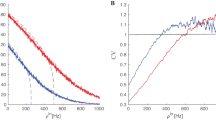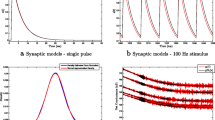Abstract
Recent experiments have shown that GABAA receptor mediated inhibition in adult hippocampus is shunting rather than hyperpolarizing. Simulation studies of realistic interneuron networks with strong shunting inhibition have been demonstrated to exhibit robust gamma band (20–80 Hz) synchrony in the presence of heterogeneity in the intrinsic firing rates of individual neurons in the network. In order to begin to understand how shunting can contribute to network synchrony in the presence of heterogeneity, we develop a general theoretical framework using spike time response curves (STRC’s) to study patterns of synchrony in a simple network of two unidirectionally coupled interneurons (UCI network) interacting through a shunting synapse in the presence of heterogeneity. We derive an approximate discrete map to analyze the dynamics of synchronous states in the UCI network by taking into account the nonlinear contributions of the higher order STRC terms. We show how the approximate discrete map can be used to successfully predict the domain of synchronous 1:1 phase locked state in the UCI network. The discrete map also allows us to determine the conditions under which the two interneurons can exhibit in-phase synchrony. We conclude by demonstrating how the information from the study of the discrete map for the dynamics of the UCI network can give us valuable insight into the degree of synchrony in a larger feed-forward network of heterogeneous interneurons.








Similar content being viewed by others
References
Abarbanel, H., Gibb, L., Huerta, R., & Rabinovich, M. (2003) Biophysical model of synaptic plasticity dynamics. Biological Cybernetics, 89, 214–226.
Acker, C., Kopell, N., & White, J. (2004) Synchronization of strongly coupled excitatory neurons:relating network behavior to biophysics. Journal of Computational Neuroscience, 15, 71–90.
Aoki, F. (1999) Increased gamma-range activity in human sensorimotor cortex during performance of visuomotor tasks. Clinical Neurophysiology, 110, 524–537.
Bartos, M., Vida, I., Frotscher, M., Meyer, A., Monyer, H., Geiger, J., et al. (2002) Fast synaptic inhibition promotes synchronized gamma oscillations in hippocampal interneuron networks. Proceedings of the National Academy of Sciences, 99, 13,222–13,227.
Bartos, M., Vida, I., & Jonas, P. (2007) Synaptic mechanisms of synchronized gamma oscillations in inhibitory interneuron networks. Nature Reviews Neuroscience, 8, 45–56.
Baudry, C., & Bertrand, O. (1999) Oscillatory gamma activity in humans and its role in object representation. Trends in Cognitive Sciences, 3, 151–161.
Chow, C., White, J., Ritt, J., & Kopell, N. (1998) Frequency control in synchronized networks of inhibitory neurons. Journal of Computational Neuroscience, 5, 407–420.
Cui, J., Canavier, C., & Butera, R. (2009) Functional phase response curves: A method for understanding synchronization of adapting neurons. Journal of Neurophysiology, 102, 387–398.
Dudek, F., & Shao, L. (2004) Mossy fiber sprouting and recurrent excitation: Direct electrophysiological evidence and potential implications. Epilepsy Currents, 4, 184–187.
Engel, A., & Singer, W. (2001) Temporal binding and the neural correlated of sensory awareness. Trends in Cognitive Sciences, 5, 16–25.
Ermentrout, B. (1996) Type 1 membranes, phase resetting curves and synchrony. Neural Computation, 8, 979–1001.
Ermentrout, B., & Kopell, N. (1990) Oscillator death in systems of coupled neural oscillators. SIAM Journal on Applied Mathematics, 50, 125–146.
Ermentrout, B., Pascal, M., & Gutkin, B. (2001) The effect of spike frequency adaptation and negative feedback on the synchronization of neural oscillators. Neural Computation, 13, 1285–1310.
Ernst, U., Pawelzik, K., & Geisel, T. (1995) Synchronization induced by temporal delays in pulse-coupled oscillators. Physical Review Letters, 74, 1570–1573.
Fisahn, A., Pike, F., Buhl, E., & Paulsen, O. (1998) Cholinergic induction of network oscillations at 40 hz in the hippocampus in vitro. Nature, 394, 186–189.
Gruber, T., Keil, A., & Muller, M. (2001) Modulation of induced gamma band responses and phase synchrony in a paired associate learning task in the human eeg. Neuroscience Letters, 316, 29–32.
Gruber, T., Muller, M., & Keil, A. (2002) Modulation of induced gamma band responses in a perceptual learning task in the human eeg. Journal of Cognitive Neuroscience, 14, 732–744.
Gutkin, B., Ermentrout, G., & Reyes, A. (2004) Phase-response curves give the responses of neurons to transient inputs. Journal of Neurophysiology, 94, 1623–1635.
Jeong, H., & Gutkin, B. (2007) Synchrony of neuronal oscillations controlled by gabaergic reversal potentials. Neural Computation, 19, 706–729.
Kurths, J., Pikovsky, A., & Rosenblum, M. (2001) Synchronization, a universal concept in non-linear science. Cambridge University Press.
LeBeau, F., Towers, S., Traub, R., Whittington, M., & Buhl, E. (2002) Fast network oscillations induced by potassium transients in the rat hippocampus in vitro. Journal of Physiology, 542, 167–179.
Mann, E., Suckling, J., Hajos, N., Greenfield, S., & Paulsen, O. (2005) Perisomatic feedback inhibition underlies cholinergically induced fast network oscillations in the rat hippocampus in vitro. Neuron, 45, 105–117.
Maran, S., & Canavier, C. (2008) Using phase resetting to predict 1:1 and 2:2 locking in two neuron networks in which firing order is not always preserved. Journal of Computational Neuroscience, 24, 37–55.
Mima, T., Oluwatimilehin, T., Hiraoka, T., & Hallett, M. (2001) Transient interhemispheric neuronal synchrony correlates with object recognition. The Journal of Neuroscience, 21, 3942–3948.
Murray, J. (1993) Mathematical biology. Springer Verlag Berlin.
Oprisan, S., & Canavier, C. (2001) Stability analysis of ring of pulse coupled oscillators: The effect of phase resetting in the second cycle after the pulse is important at synchrony and for long pulses. Differential Equations and Dynamical Systems, 9, 243–258.
Oprisan, S., & Prinz, A., Canavier, C. (2004) Phase resetting and phase locking in hybrid circuits of one model and one biological neuron. Biophysical Journal, 87, 2283–2298.
Sejnowski, T. (1986) Open questions about computation in cerebral cortex. MIT Press, Cambridge.
Strogatz, S. (2001) Nonlinear dynamics and chaos with application to physics, biology, chemistry and engineering. Westview Press.
Talathi, S., Hwang, D., & Ditto, W. (2008) Spike timing dependent plasticity promotes synchrony of inhibitory networks in the presence of heterogeneity. Journal of Computational Neuroscience, 25, 262–281.
Talathi, S., Hwang, D., Miliotis, A., Carney, P., & Ditto, W. (2009) Predicting synchrony in heterogeneous pulse coupled oscillators. Physical Review E, 80, 021908.
vanVreeswijk, C., Abbott, L., & Ermentrout, B. (1994) When inhibition and not excitation synchronizes neural firing. Journal of Computational Neuroscience, 1, 313–321.
Vida, I., Bartos, M., & Jonas, P. (2006) Shunting inhibition improves robustness of gamma oscillations in hippocampal interneuron networks by homogenizing firing rates. Neuron, 49, 107–117.
Wang, X., & Buzsaki, G. (1996) Gamma oscillation by synaptic inhibition in a hippocampal interneuronal network model. The Journal of Neuroscience, 16, 6402–6413.
Wang, X., & Rinzel, J. (1992) Alternating and synchronous rhythms in reciprocally inhibitory model neurons. Neural Computation, 4, 84–97.
White, A., Chow, C., Ritt, J., Trevino, C., & Kopell, N. (1998) Synchronization and oscillatory dynamics in heterogeneous, mutually inhibited neurons. Journal of Computational Neuroscience, 5, 5–16.
Whittington, M., Traub, R., & Jefferys, J. (1995) Synchronized oscillations in interneuron networks driven by metabotropic glutamate receptor activation. Nature, 373, 612–615.
Winfree, A. (2001) The geometry of biological time, 2 edn. NY: Springer Verlag.
Wolf, F., & Geisel, T. (2008) Neurophysics:logic gates come to life. Natural Physique, 4, 905–906.
Acknowledgements
This work has been supported in part through a grant from the Office of Naval Research (Grant Number N00014-02-1- 1019), the National Institute of Biomedical Imaging and Bioengineering through Collaborative Research in Computational Neuroscience (R01EB004752) and (EB007082) and the Wilder Center of Excellence for Epilepsy Research at the University of Florida. We acknowledge Dr P. Khargonekar, Dr H. Abarbanel and the anonymous reviewer’s for their valuable comments and suggestions on this manuscript.
Author information
Authors and Affiliations
Corresponding author
Additional information
Action Editor: N. Kopell
Rights and permissions
About this article
Cite this article
Talathi, S.S., Hwang, DU., Carney, P.R. et al. Synchrony with shunting inhibition in a feedforward inhibitory network. J Comput Neurosci 28, 305–321 (2010). https://doi.org/10.1007/s10827-009-0210-2
Received:
Revised:
Accepted:
Published:
Issue Date:
DOI: https://doi.org/10.1007/s10827-009-0210-2




